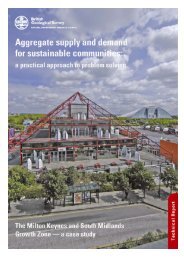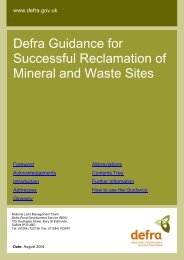creating environmental improvements through biodiversity
creating environmental improvements through biodiversity
creating environmental improvements through biodiversity
Create successful ePaper yourself
Turn your PDF publications into a flip-book with our unique Google optimized e-Paper software.
The training programmes cover the following topics:<br />
• Identifying, planning and implementing restoration activities<br />
• Grassroots advocacy<br />
• Collaborative fundraising<br />
• Media, outreach and communication<br />
• Partnership building<br />
• Volunteer recruitment activities<br />
Once a workshop has been completed, volunteer participants have the tools necessary to become active<br />
in an abandoned mine land restoration project and become effective and knowledgeable issue advocates.<br />
Participants are also introduced to the appropriate agency staff to ensure meaningful post-workshop followup.<br />
GRASSROOTS TRAINING PROJECT: EUSTACHE - NINEMILE CREEK,<br />
MONTANA<br />
One of the first grassroots workshops was held in Montana. Participants were introduced to seven concepts<br />
to guide their volunteer involvement in the Eustache restoration project. By avoiding technical and regulatory<br />
information, the workshop enabled a collaboration-focused, positive approach to evaluating, planning,<br />
implementing and monitoring abandoned hardrock mine restoration projects. It became clear that to be<br />
successful, workshops must incorporate a relevant and tangible local project in order to facilitate desired<br />
follow-<strong>through</strong> action and provide for meaningful participant involvement. Future training site selection will<br />
be determined by watershed priority, current and planned partner agency investment, short-term success<br />
potential, current and potential strength of local Trout Unlimited organization and additional partnership<br />
potential.<br />
Sustainable Aggregates Creating Environmental Improvements <strong>through</strong> Biodiversity<br />
The Place: Eustache Creek is a headwater tributary of Ninemile Creek in Missoula County, Montana. It<br />
is one of the most important production areas for native cutthroat trout in the Ninemile Creek watershed,<br />
which flows into the Clark Fork River 25 miles west of Missoula, Montana. Eustache Creek is also one of<br />
the only places in the Ninemile Creek watershed where bull trout, a federally threatened species, have been<br />
recently documented. Ninemile Creek is listed as Water Quality Limited under section 303(d) of the Clean<br />
Water Act.<br />
The Problem: Eustache Creek has been subjected to sporadic placer mining activity since 1875. This<br />
mining eliminated much of the natural channel structure (e.g., pools and riffles). Piles of dredged material,<br />
approximately 10–15 feet in height, occupy much of the valley bottom and impede the function of the<br />
floodplain. Ponds left by dredging also add sediment to the creek and disrupt the natural stream flow,<br />
which causes water to stagnate and water temperatures to increase – a severe impediment to native fish<br />
reproduction.<br />
The Partners: The Westslope Chapter of Trout Unlimited and the Lolo National Forest have entered<br />
a partnership agreement to restore a one-mile section of the creek to create habitat for native fish and<br />
improve water quality for the community downstream. Other partners in the project include the Ninemile<br />
Watershed Group, Friends of the Ninemile, and Montana Trout.<br />
The Price: Over three years the projected cost for the Eustache Creek project would be $56,950. Estimates<br />
include the permitting and contract work, riparian stock collection and stream reconstruction of the<br />
Eustache Creek mine site.<br />
99

















